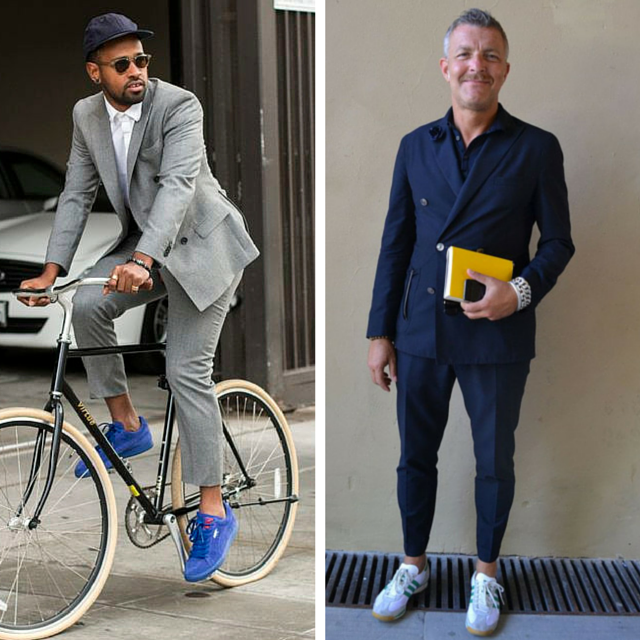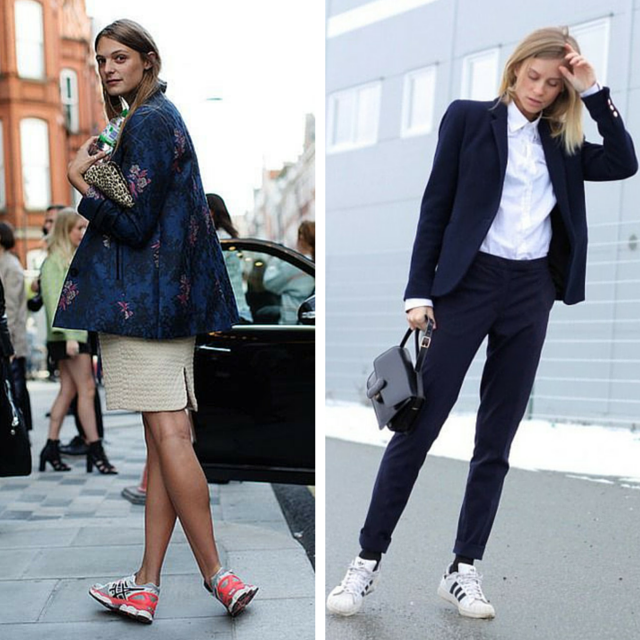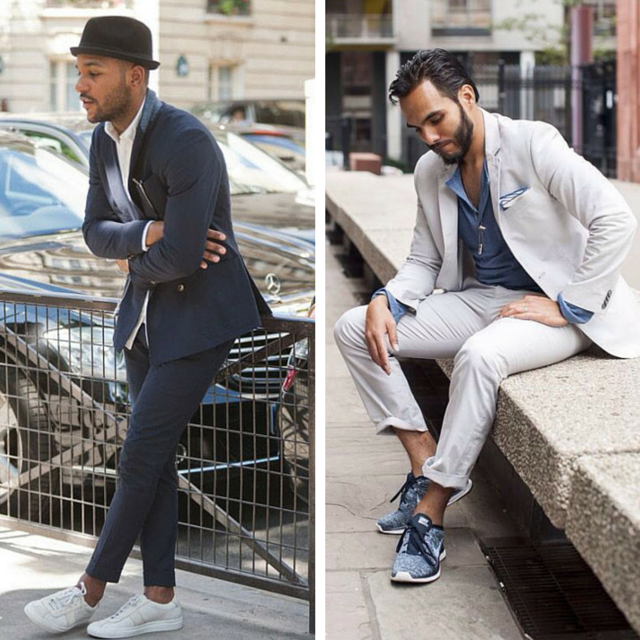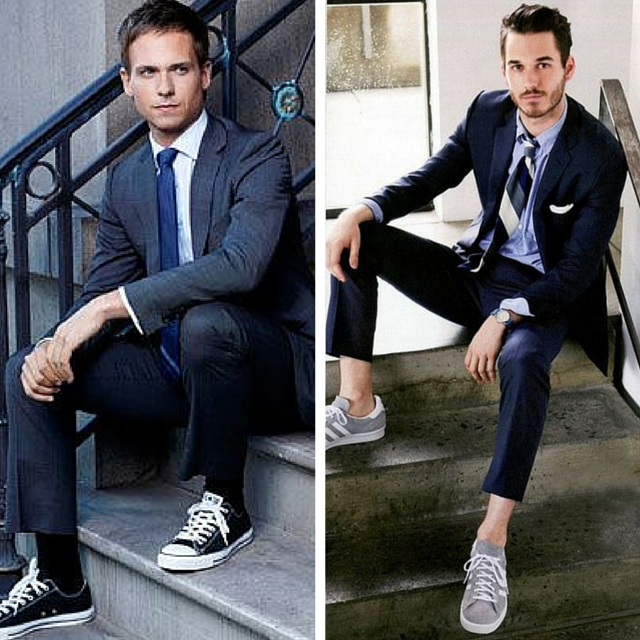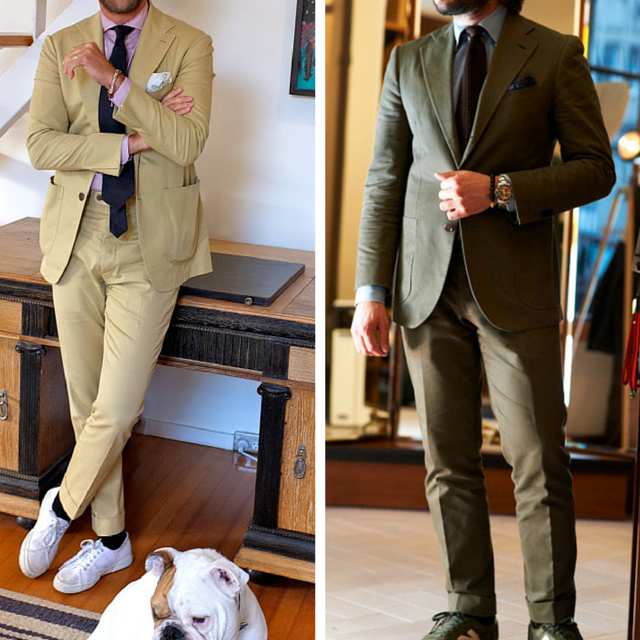After spending a few days in Los Angeles last week I was reminded that it is one of the few major cities that is equally as casual as Vancouver. Don’t get me wrong; it’s most definitely a fashionable city but one that finds its voice from a very laid back place.
We in Vancouver share a very similar fashion DNA – comfort more often than not takes precedence though we’re looking to be on point and maintain a put together aesthetic. Enter the high-low style.
What is the high-low style?
The high-low style is a concept were you take a fairly dressed up look and reduce its formality by pairing it with one or two distinctly casual pieces. The most common method is to take a suit as the base and then reduce by way of your footwear – particularly via trainers. The second element is often more subtle as can be seen in the images below. On the left it’s the fact that he forgoes the tie yet buttons-up. The hat also brings the look down one notch further still. The fellow on the right uses a short sleeved cotton dress polo (a polo shirt with a dress shirt collar) in the place of a dress shirt to the same effect.
The key with both of these looks is that they aren’t far off being elevated back up the formal scale. Change out the trainers for leather lace-ups and both guys are essentially back; add a tie to the guy on the left and he’s ready for the boardroom.
The concept came to my mind years ago as a way to describe how European women effortlessly walked this line; an aesthetic that was loosely referred to as casual chic at the time. For me it was the ultimate because while it was clear that they weren’t trying to be dressed up they were most definitely fully put together. This is a subtle but crucial difference.
Dressed up verses put together.
With menswear when you’re dressed properly it really comes down to nailing all the details. A crisp, perfectly fitted suit; the polished lace-ups that perfectly compliment the color of the suit; the socks, tie and pocket square that compliment both yet add a hint of punch to the look. Each individual piece needs to sync with one another and seamlessly bring the outfit together.
The high-low turns this on its head by implementing the one or two pieces from an entirely different stylistic place. In the end it’s the lack of syncing up that adds visual interest and personality. It’s completely put together and thought out though the feel and the intended messaging is totally altered.
Why do we use the high-low style?
For me it was the desire in my early twenties to go against my naturally preppy appearance. I used trainers and sportswear pieces to change the feel – the goal being to look put together and fashionable but not overly polished. Twenty years on and its still playing the same role for me in certain situations.
The same goes for Vancouver as a city – and while we’re at it Seattle, Portland, San Francisco and Los Angeles. We’re not the East Coast nor are we anything close to Europe. We’re constantly wary of being overdressed and searching for ways to reduce formality. The high-low style fits our scenario perfectly – thoughtfully put together but with a laid back west coast sensibility.
Loose rules.
Unstructured is easier.
There is a lot of buzz right now about unstructured jackets which is odd considering the Italians have used them for decades. With a warmer climate the idea is to reduce as much excess bulk in the jacket as possible; removing a layer of canvas, reducing or remove padding in the shoulder all together and perhaps eliminate the lining. This instantly gives a softer look and lighter feel while maintaining a sharp silhouette. This is more casual in nature and simply more comfortable which is crucial in achieving a successful high-low.
Remember you’re not really wearing a suit.
If you were then you’d have proper dress shoes on and we wouldn’t be talking about the high-low! With that in mind think of it as though you are wearing the pieces of a suit as opposed to wearing a suit itself. It’s a subtle though very important distinction.
As such feel free to un-tuck your shirt, play with the length of your pant hem, pair it with a bowler hat – generally express yourself any way that feels right.
When wearing a tie it’s all about the fabric.
Flying in the face of convention is an element of the high-low style. That said you need to know where you can push the rules and where you can’t. The tie creates a dangerous scenario – look at the two images below:
I won’t mention the magazines that promoted these looks but essentially they said it’s okay to wear trainers with fully put together suit and tie looks – I disagree. The above images are of suits made from smooth worsted fabrics which represent the pinnacle of formality. Simply changing out the shoes doesn’t achieve a successful high-low – if anything it makes a bit too try hard. Avoid at all costs.
The images below however are a different case.
The difference is in the cloth – these two suits being made from cotton. By reducing the formality of the cloth in the base suit you’re then able to play the high-low game while choosing to go with a tie.
Play around.
In the end it’s about delicately walking the line between the two levels of formality. How you do that comes down to your personality as well the context that you’re dressing for. The message you’re trying to promote in the tech sector is completely different than if you’re an advertising executive which is different still if you’re in the entertainment business. The key is that you read the level of formality required for you field and start to play with it until you find something that works for you.
No doubt the high-low style takes a bit of trial and error and is higher on the difficulty scale than a lot of other looks. Don’t hesitate to get in touch if you have any questions – you can also set up a free appointment to talk it through and see if we might be a good fit to work together.
Take care,
Michael
info@martinfishertailors.com

